Uttarakhand is a state in North Indian region of Himalayas. The state is popularly known as Devbhumi (land of Gods) due to the presence of numerous hindu pilgrimage sites. As a result, religious tourism forms a major portion of the tourism in the state.
Being the originating point of significant Indian rivers, Uttarakhand is the abode of some of the best hill stations in north India. While the winter season can offer you the best views of snow packed mountain ranges, the same ranges can be the comfort zones in the scorching summer. From thrilling mountain climbing to relaxing leisure walk, each single activity is delightful and worthy to time spending. The state’s also forested Jim Corbett National Park shelters Bengal tigers and other native wildlife.
Below is the list of top must-see tourist places in Uttarakhand region in India.
Nainital
Nainital is a Himalayan resort town in the Kumaon region of India’s Uttarakhand state. It is a popular hill station in the Indian state of Uttarakhand and headquarters of Nainital district in the Kumaon foothills of the outer Himalayas. Situated at an altitude of 2,084 metres (6,837 ft) above sea level, Nainital is set in a valley containing a pear-shaped lake, approximately two miles in circumference, and surrounded by mountains, of which the highest are Naina (2,615 m (8,579 ft)) on the north, Deopatha (2,438 m (7,999 ft)) on the west, and Ayarpatha (2,278 m (7,474 ft)) on the south. From the tops of the higher peaks, “magnificent views can be obtained of the vast plain to the south, or of the mass of tangled ridges lying north, bounded by the great snowy range which forms the central axis of the Himalayas.
Formerly a British hill station, its set around Nainital Lake, a popular boating site with Naina Devi Hindu Temple on its north shore. There’s shopping in Bara Bazaar, and hiking trails with mountain views crisscross the surrounding area’s wooded hills.
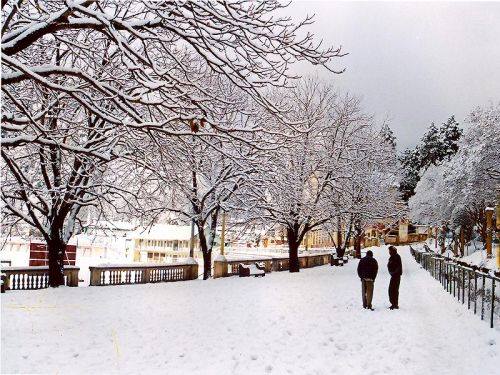
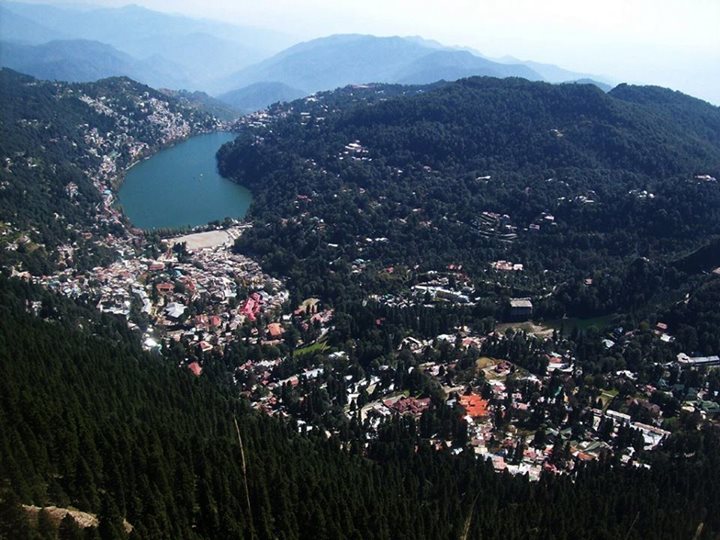

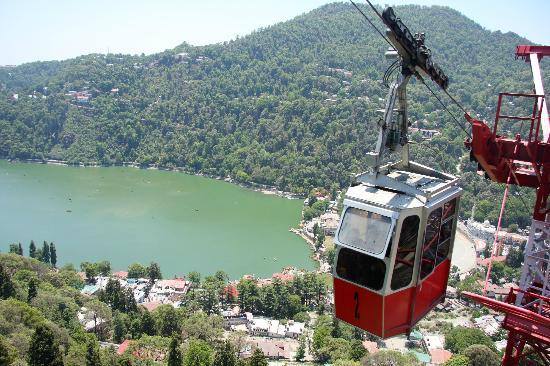
Kausani
Kausani is located 52 km north of Almora. Situated at an elevation of 1890 meters Kausani is a picturesque hill station famous for its scenic splendour and its spectacular 300 km-wide panoramic view of Himalayan peaks. Window to the snow-crested Trishul, Nanda Devi, Nandakot and Panchchuli peaks, there are very few places in the Himalayas whose beauty can be compared to that of Kausani. Mahatma Gandhi called this place the ‘Switzerland of India’, due to similarity in landscape. Though Kausani is not as well known as any of the other hill stations, the area is full of deep and dense pine forest and tea gardens. Major attractions around Kausani are the Temple town of Bageshwar situated at the confluence of the river Sarayu and Gomti, the Gandhi Ashram and the Rudradhari falls and caves.
Ranikhet
Ranikhet is a hill station and cantonment town in Almora district in the Indian state of Uttarakhand. It is at an altitude of 1869 metres above sea level and within sight of the western peaks of the Himalayas. Ranikhet has everything to pacify the nerves of an avid city dweller. The literal meaning of word Ranikhet is Queens Land. It is a place that reflects the best of the great Himalayas. The charming and majestic views of the pine trees, lush green forests, delicate plant life and attractive wild life, the scented mountain breeze, the fresh and pure, the singing of birds, the panoramic view of the Himalayas sight, all adds to the heavenly and pure feeling of Ranikhet.
One of the significant hill stations in north India, Ranikhet is a must see tourist spot for the adventure loving youths. Apart from bewitching topography, the region attracts many tourists for the amazing trekking trails. Paragliding camps are organized by different tour organizer groups. The campsite is around 12km ahead of the main town of Ranikhet and located by the oak forest. There is airy safari tents to smaller trekking tents in this area to add to your comfort. You can also choose to spend a leisure night in old style stone houses of the village. There are a few beautiful temples at Ranikhet, among which Jhula Devi Temple, Binsar Mahadev Temple, Katarmal (Sun Temple) are noteworthy.
Mussoorie
Mussoorie, the queen of the hills, is one of the most popular and fascinating hill resorts of northern India. Its green hills and varied fauna and flora make it a colourful and picturesque hill station, commanding a wonderful view of extensive Himalayan snow ranges to the North-East, and Panoramic view of the Doon valley to the south.
Mostly known as the ‘queen of the hills’, is one of the most popular and fascinating hill resorts of northern India. . Its green hills and varied fauna and flora make it a colourful and picturesque hill station, commanding a wonderful view of extensive Himalayan snow ranges to the North-East, and Panoramic view of the Doon valley to the south. The average altitude of Mussoorie is 1,880 m whereas the highest peak is more than 2,290m high making it a paradise for the thrill seekers. March to June and September to November is the best time to visit this splendid spot. Some of the most enticing trekking trails in Mussoorie are:
- Bhadraraj Temple trek (15 km)
- Benog Hill Trek – (3 km)
- George Everest Park – (3 Km)
- Kempty Falls Trek – (8 km)
- Yamuna Bridge trek – (20 km)
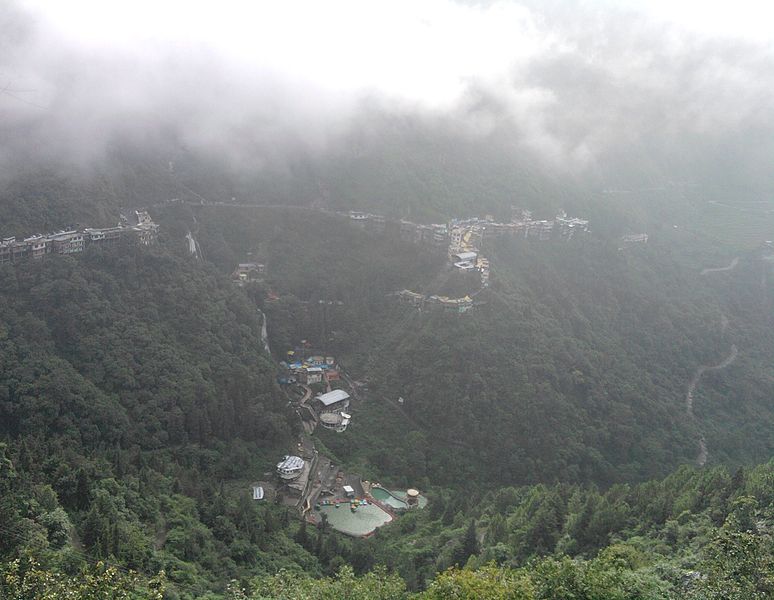
Bhimtal
Bhimtal situated at an altitude of 1370 meters above sea level and is about 22 kilometers from Nainital. The major attraction in Bhimtal is the Bhimtal Lake, which has an island at its centre. This sprawling hill station enjoys a pleasant weather throughout the year. Bhimtal Lake has a strategically located restaurant at its centre, from where one can enjoy the scenic beauty of the entire lake. Boating on its calm water is an incredible experience. One can indulge in rappelling or rock climbing in Bhimtal. Bhowali, Kainchi, Gorkhakhal, Bhimeshwar temple are some of the must see spots near Bhimtal.
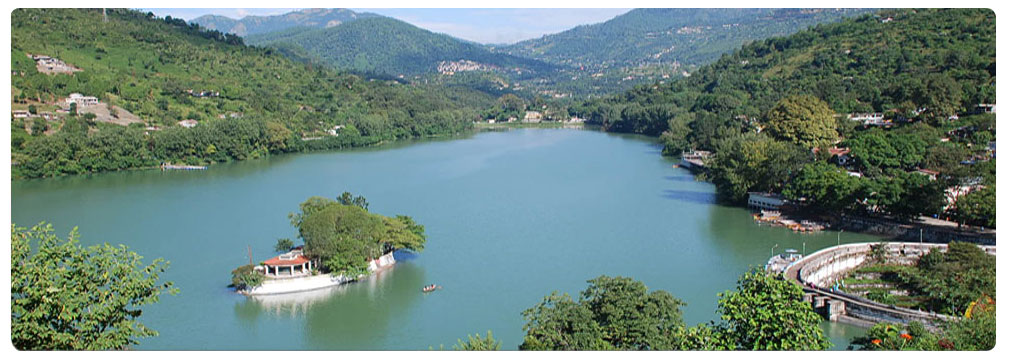
Naukuchia Tal
Naukuchiatal or ‘lake of nine corners’ is a small hill station in Nainital district of the Indian state of Uttarakhand. The lake is 175 feet deep and is situated at 1220 mts above sea level. It is surrounded by hills covered in trees and shrubs. Naukuchiatal is the deepest of all the lakes in the Nainital region. It is within an enchanting valley offering an opportunity of angling and bird watching. Unpolluted, clamor-free environ is echoed with the chirping of birds. Enjoy paddling by the lake side which is a great experience.
A picnic to this beautiful place also offers one with the tempting challenges like paragliding, fishing, rowing, paddling or yachting. Naukuchiatal will even enchant the picnicker with the rare adventurous activity of parasailing. The lake is fed by an underground perennial spring.
Sattal
Sat Tal is a cluster of mysteriously interconnected seven freshwater lakes situated 19 km away from Naukuchia Tal. Sat Tal is set at an altitude of 1370 mts above sea level. The group of lakes is set amidst dense forests of oak and pine trees. These lakes are paradise for migratory birds as they stay for some time here during their migration. Sattal is one of the few unspoiled and unpolluted fresh water biomes in India. The names of the seven lakes of Sattal are Purna Tal, Ram Tal, Sita tal, Laxman Tal, Nal Damyanti Tal, Sukh Tal and Garud Tal. Sattal is often compared with Westmoreland of England by Britishers.
Mukteshwar
It is situated at a distance of 20 km from Naukuchiatal set at an elevation of 2,285mts above sea level. Mukteshwar got its name from a 350year old temple Mukteshwar Dham whose presiding deity is great Lord Shiva. The top of the mountain on which Mukteshwar Dham is stood offers stupendous views of Himalayan range. Witnessing the breath taking natural ambiance of Himalaya from the temple premise is unforgettable.
Attractions: Mukhteshwar Temple, Methodist Church, Indian Veterinary Research Institute, Chauli-ki-Jali, The Market and Mukhteshwar Inspection Bungalow.
Activities: Rock climbing, nature walks, rappelling, trekking, Heritage viewing, camping and yoga programs.
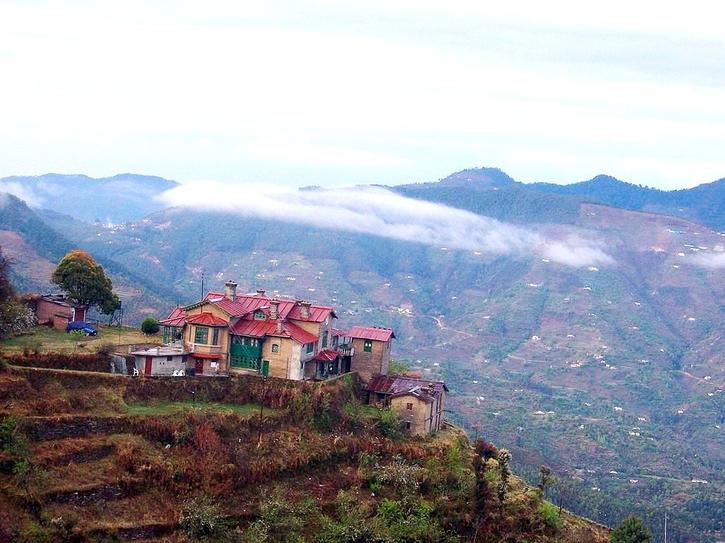
Auli
Auli is an important ski destination in the Himalayan mountains of Uttarakhand, India. It is located at an elevation of 2500 to 3050 meters above sea level. Auli lies on the way to Badrinath. It is surrounded by coniferous and oak forests, with a panoramic view of the lofty peaks of one of the greatest mountain range in the world, the Himalayas. The slopes here provide enough thrill to professional skier and novice as well. Auli also boasts the Asia’s longest – 4 km – cable car (Gondola). It also has a Chair Lift and a Ski-Lift. Apart from Skiing there is an interesting trek route also. If you love to go for trekking, Auli to Badrinath and Auli-Kuari Pass trek are some of the best places for adventure trekking in Uttarakhand.
Witnessing the panoramic view of the Himalaya from Gondola can be an unforgettable experience. Best time to visit is January to March when nature decors the land with dusty snow. Though weather is highly unpredictable.
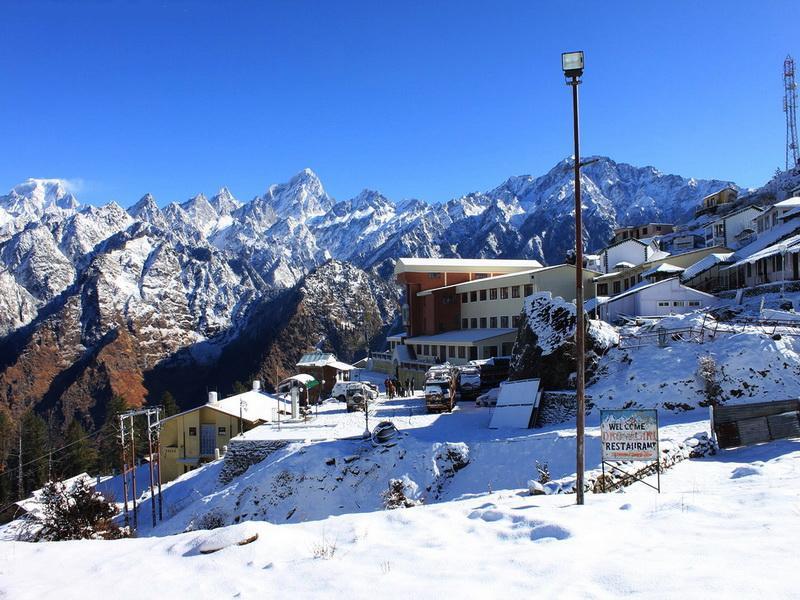

Dhanaulti
This place makes it into the wishlist of many people, as it offers a serene escapade from the hectic city life right to the grazing lands and beautiful forests. That’s not all! Apart from the picturesque environment, Dhanaulti also presents to you, the opportunity to indulge in adrenaline pumping activities, thereby making it a great vacation package.
Attractions: Eco Park, Surkanda Devi Temple, Potato Farm, Thangdhar, Joranda and Barehipani falls, Dashavatar Temple, Chanderi, Deogarh Fort, Pradhanpat viewpoint and Matatila Dam.
Activities: Nature walks, trekking, horse riding, camping, mountain biking and rappelling.
Badrinath
Badrinath is the abode of Lord Vishnu, who is called ‘Badri Vishal’, Badri the Big One. Legend has it that Badrinath was in fact the abode of Lord Shiva, who used to reside there with His consort Mother Parvati. Lord Vishu happened to like the place and wished to reside there permanently, so He took the form of an infant and started crying inconsolably. Mother Parvati’s heart melted and she picked up the infant Vishu and started cradling Him. The crying of the infant, however, disturbed the meditation of Lord Shiva and unable to bear the crying He left for higher reaches of the Himalayas and made Kedarnath His home. Once Lord Shiva left Mother Parvati too followed, which gave an opportunity to Lord Vishnu to take His original form and remain at Badrinath forever. The priests of Badrinath are from the southernmost part of India, i.e. Kerala. This is according to the rules laid down by Adi Sankara. Badrinath remains out of bounds for pilgrims for 6 months a year, from October to May.
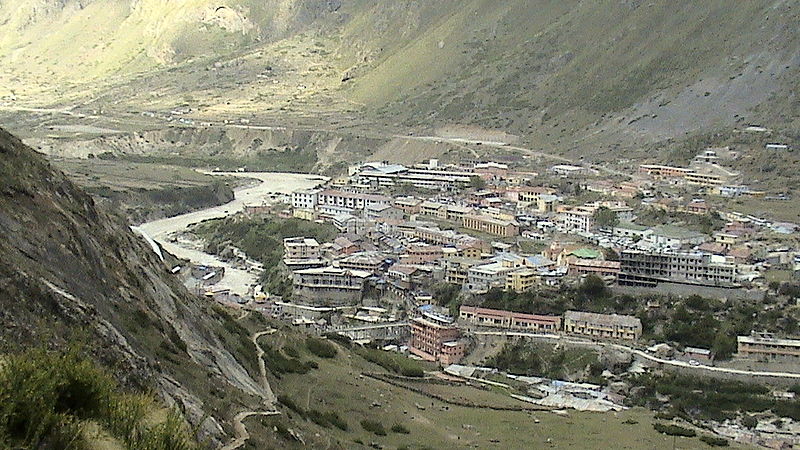
Kedarnath
Kedarnath is the abode of Lord Shiva. It is one of the 12 Jyotirlingams of India and the only one in the Uttarakhand. While there is a motorable road to Badrinath, Kedarnath could only be reached by foot. The 14 km trek begins from Gaurikund. After the 2013 Himalayan floods, the trek currently is of more than 18 km due to washing away of trekking paths.
Gangotri
Gangotri is the origin of the holy river Ganga. River Ganga is revered as a mother throughout India. According to the Hindu philosophy, a place considered extremely holy if a river running through it flows in the northern direction. Gangotri is a place which is not only the origin of Ganga but also where Ganga flows in a northerly direction, hence the name ‘Gangotri’. The river Ganga flows out from the melting Gangotri glacier, which is at a distance of around 18 km from the Gangotri town. Close to the temple is Bhagirath Shila, which according to the Hindu philosophy is the place where Bhagirath did penance for 5500 years to seek the blessings of Mother Ganga and requested Her to descend to the earth from Her heavenly abode to cleanse the sins of his ancestors.
Yamunotri
Yamunotri is the origin of the holy river Yamuna. A temple dedicated to the holy river Yamuna is situated at the place. The actual origin of the river is the Yamunotri glacier further up into the Himalayas where very few pilgrims go due to the difficulty it entails.
Valley of Flowers
For the nature worshippers of the neighbouring regions to Uttarakhand, the Valley of Flowers National Park is a paradise. This famous World Heritage Site is located at an elevation of 3658 m above sea level and covers an area of 87.50 sq km of Myriad Alpine flowers. This boundless land of multihued flowers is perched with many nameless species of flowers including some of the significant species like Brahmakamal, Cobra Lily, Blue Poppy and a lot more. Other than nature lovers, this can be a paradise for Botanists. Trekking is the ideal way to explore this myriad flower bed. This 3 days trek passes through the precarious cuts on the mountain sides and edges the serpentine source of river Ganga. The trek starts from Govind Ghat and ends at Ghangria.
Hemkund Sahib
Only 2.1 miles from the mesmerising Valley of Flowers (VOF), Hemkund Sahib is the highest Gurdwara of the Sikh community. It is located at an elevation of around 4329 m above sea level. This holy place is situated in the bank of a pristine lake which is watered by the melting Himlayan snow. The shrine is surrounded by seven peaks – known as the Sapt Sring. It is believed that the tenth Guru of the community, Guru Govind Singh Ji meditated on the hills of Hemkund and thus the abode is dedicated to this great soul. The shrine is built in star shape and the vicinity is fascinating. One can complete trekking to Valley of Flowers and can reach at Hemkund for relaxation.
If anybody want to explore Uttarakhand, you can get details at http://uttarakhandtourism.gov.in